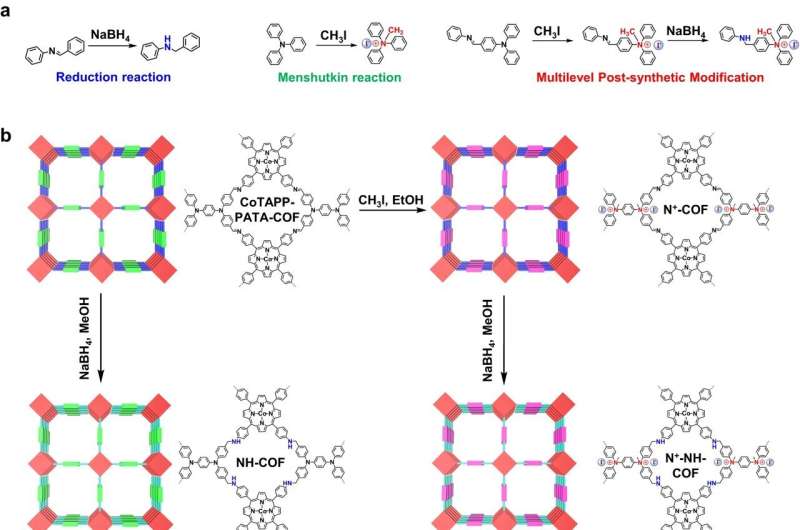This article has been reviewed according to Science X's editorial process and policies. Editors have highlighted the following attributes while ensuring the content's credibility:
fact-checked
peer-reviewed publication
trusted source
proofread
Researchers propose post-synthetic modification of covalent organic frameworks for carbon dioxide electroreduction

Covalent organic frameworks (COFs), possessing ordered pores and high-precision functionalization, are regarded as an ideal class of templates to construct catalysts for electrocatalytic carbon dioxide reduction reaction (CO2RR).
C-N bonds can improve adsorption of CO2 and ionic skeletons can promote charge transfer, further enhancing conductivity. However, direct bottom-up synthesis can hardly realize co-existence of C-N bonds and ionic frameworks due to the electrostatic repulsion and weak strength of the linkage.
A research team led by Prof. Zeng Gaofeng and Assoc. Prof. Xu Qing from the Shanghai Advanced Research Institute (SARI) of the Chinese Academy of Sciences has proposed a multilevel post-synthetic modification strategy to construct catalytic COFs towards CO2RR with high activity and selectivity.
The results were published in Nature Communications.
Catalytic COFs synthesized by the post modification showed a maximum turnover frequency value of 9922.68 h–1 at –1.0 V and the highest faradaic efficiency of 97.32% at –0.8 V, which were higher than that of the base COF and the single-modified COFs.
Electrocatalysis tests and characterizations revealed that C-N bonds could improve catalytic selectivity and ionic skeleton contributed to higher activity.
Furthermore, theoretical calculations illustrated that the easier formation of immediate *CO from COOH* was the rate-determined step, and methyl groups strengthened electron density.
This work provides a deeper understanding of COFs in CO2 reduction reaction. It sheds light on constructing multilevel post-synthetic modification COFs towards tailored activity and high stability.
More information: Minghao Liu et al, Post-synthetic modification of covalent organic frameworks for CO2 electroreduction, Nature Communications (2023). DOI: 10.1038/s41467-023-39544-9
Journal information: Nature Communications
Provided by Chinese Academy of Sciences





















